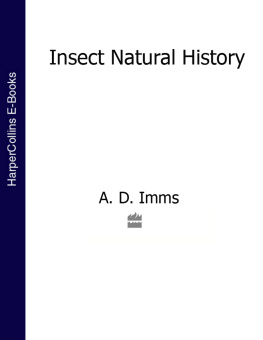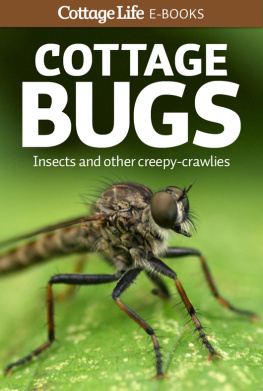
Bugs Rule!
Bugs Rule!
An Introduction to the World of Insects
WHITNEY CRANSHAW AND RICHARD REDAK
Princeton University Press
Princeton and Oxford
Copyright 2013 by Princeton University Press
Published by Princeton University Press, 41 William Street, Princeton, New Jersey 08540
In the United Kingdom: Princeton University Press, 6 Oxford Street, Woodstock, Oxfordshire OX20 1TW
press.princeton.edu
Cover photograph: Milkweed longhorn by David Leatherman.
All Rights Reserved
ISBN 978-0-691-12495-7
Library of Congress Control Number: 2013934688
British Library Cataloging-in-Publication Data is available
This book has been composed in Sabon LT Std by SPi Publisher Services, Pondicherry, India.
Printed on acid-free paper.
Printed in Korea
10 9 8 7 6 5 4 3 2 1
Dedication
This book is dedicated to Bill Cranshaw, whose boundless curiosity about the worldand his passion for bookswill always inspire.
Contents
Preface
Bugs Rule! An Introduction to the World of Insects was originally conceived to meet the needs of an entomology course taught to nonscience majorsthe type of course where you have only one shot to get across everything-you-need-to-know-about-insects to a group of students with little previous exposure to the subject. And although such students rarely have the opportunity to take more advanced courses in entomology, it is always hoped that their initial exposure will open them up to a lifetime of learning about the subject.
There have been many influences affecting the development of this book. Probably the greatest have been entomology books that approached the subject by often talking about individual insects or insect groups,their life history, and how they intersect with humans. Life on a Little Known Plant , by Howard Ensign Evans, will always remain a classic in this regard, able to open the world of insects by his use of fascinating details combined with an enjoyable, highly readable style. More recently, there have been a substantial number of contributions by May R. Berenbaum, through both her columns and books (e.g., Ninety-Nine Gnats, Nits, and Nibblers; Bugs in the System: Insects and Their Impact on Human Affairs) that have helped familiarize and popularize all manner of insect subjects. Also of great influence was the emergence of some highly successful entomology courses around the country that engaged large numbers of students, such as what Tom Turpin achieved at Purdue University, accompanied by his Insect Appreciation Digest .
The authors have also reviewed and considered most of the books that have been developed to teach a more standard entomology course. Many do an excellent job in teaching the basics of entomology needed for students with a biology orientation. In our opinion, The Insects: An Outline of Entomology by Gullan and Cranston (now in its fourth edition) is a particularly thorough and well-organized book for teaching entomology. Borror and DeLongs Introduction to the Study of Insects (now in its seventh edition) by Johnson and Triplehorn is also considered to be a standard and has been used by the authors as the guide for present taxonomya constantly shifting and debated subject. Insight into phylogenetic relationships and insect evolution are particularly well handled in Evolution of Insects , by David Grimaldi and Michael S. Engel.
Drawing from all these resources and many more, Bugs Rule! has its own approach to the subject. Overall, the book is more natural history oriented than are standard entomology textbooks. Many of the basics are presentsuch as anatomy, physiology, systematicsbut these are given a fairly compressed treatment within introductory chapters, and later referenced as appropriate when specific insect groups are discussed. The great majority of the book is an introduction to the cast of charactersthe various insect orders with a bit of emphasis on some of their more important or poignant (to our eyes) members.
Some features of this book differ considerably from what one finds in most entomology textbooks. Perhaps most notable is the fairly extensive treatment given to the noninsect arthropodscrustaceans, myriapods, and particularly the arachnids (spiders, mites, scorpions, etc.). Most people lacking a formal course in entomology appear to have a somewhat vague idea about the arthropods, considering them all to be bugs of some sort. And manya great manyof the questions that they typically have about bugs involve arachnids. So this book tries to include a bit more information about these fascinating animals that typically get sidestepped.
Also likely to be a bit controversial are a few topics that respond to common questions students have expressed. Do insects sleep? and Do insects feel pain? come immediately to mind. We recognize that there remains considerable debate about such matters. As a result they are typically ignored as textbook subjects; we chose to attempt a coverage of the topics.
Both the authors have long taught the type of introductory courses for nonscience majors that Bugs Rule! is designed to support. We hope it will be useful to others who are in the business of increasing entomological (in a very broad sense) literacy or who just want an introduction of their own to the fascinating life of arthropods.
Acknowledgments
So many have assisted in so many ways to help bring this book to completion.
The extensive use of imagesphotographs, figure drawings, and other illustrationswas critical to the production of this project, and scores of people have contributed in this area. Credits have been provided with each illustration, but there are some individuals who have made exceptional contributions and, we feel, deserve special recognition and thanks. This starts with the three photographers that are most heavily represented within these pagesBrian Valentine (Lord V), Tom Murray, and Jim Kalisch, each an amazingly talented and productive photographer of all types of arthropods. One will also find Gary Alpert, Scott Bauer, Joseph Berger, Mark Chappell, William Ciesla, Tom Coleman, Jillian Cowles, Susan Ellis, Ken Gray, David Leatherman, Gerald Lenhard, Sturgis McKeever, Herbert A. Pase, Jr., S. Dean Rider, and James Solomon well represented within this book. Then there were a few individuals we were able to go to repeatedly for help with the images we found most difficult to locateAlex Wild (Hymenoptera and rock crawlers), Scott Turner (termites), Lynn McCutcheon (arachnids), David Shetlar (all manner of oddities), and Jack Kelly Clark (the California connection).
Matt Leatherman was our main illustrator, to whom we turned repeatedly for help in providing critical illustrations, particularly in the early chapters. Illustrations related to medical/veterinary entomology rely heavily on those provided by Scott Charlesworth with Purdue University and the Centers for Disease Control. The historical illustrations produced by the Department of Entomology within the Smithsonian Institution, primarily penned by Art Cushman, were also used extensively.
Boris Kondratieff provided great guidance to the original development of the text, others in review, including Mike Rust, Wayne Brewer, Paula Cushing, Mike Rust, Tom Weissling, Richard Zack, and anonymous reviewers. All comments are appreciated and helped improve the book.
As this project finally moved to end stages (following too many years of undue tardiness by the authors!), the folks in Princeton University Press worked magic. Terri OPrey took over to keep production on schedule, with Larissa Klein assisting. The primary editing and all layouts were coordinated by Gunabala Saladi and her staff at SPi Global. Throughout, from the original conception of the project and through the rocky periods, Robert Kirk shepherded the process.
Next page






